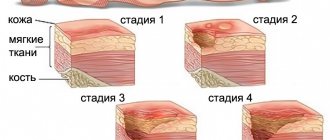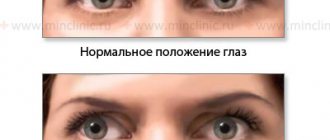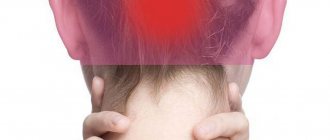Unpleasant sensations and pain in the head and eyes are familiar to everyone. This condition often only indicates overfatigue of the visual analyzer, especially during prolonged work at the computer. Therefore, when the eyes hurt when the pupils move, and a person feels dry, as if sand had gotten into them, at the first stage it is necessary to give the eyes a rest (especially if you feel pain in the eyes when working at the computer or reading). However, if this does not help, then it is necessary to exclude pathological processes that manifest themselves with similar symptoms from the visual analyzer. It can be:
- 1. Increased intraocular pressure. In this case, a person most often feels that the eye hurts inside. This condition can be transient and accompany, for example, migraine or brain pathology, or it can be permanent and lead to gradual retinal detachment associated with glaucoma. In this case, the eyeball becomes rocky when palpated.
- 2. Infectious diseases of the eyes, brain and intoxication. Inflammation of the mucous membrane of the eye - conjunctivitis - is a common cause of pain when blinking and at rest. Pain in the orbit that occurs when moving the eyes indicates that the eye muscles and nerves are involved in the inflammatory process. This situation can occur both during intoxication due to common flu or acute respiratory infections, and during such serious diseases as meningitis, encephalitis, etc. Inflammation of the paranasal sinuses (sinusitis or sinusitis) can cause pain in the nose and eyes. With the development of complicated forms of these diseases, pus can penetrate into the orbital cavity.
- 3. Trauma to the eyeball, head and facial skull can lead to pain in the orbits and eyes. The reason is direct mechanical impact or the entry of foreign objects into the visual analyzer. A concussion may also cause pain in the forehead or temple when moving the eyes.
- 4. Diseases of the eye appendages. A number of diseases can lead not to an eye problem, but to inflammation of the lacrimal glands (dacryocystitis) or eyelids (maybeitis).
Causes of pain
The head in the forehead area can hurt without damage to the internal organs. The cause may be mental fatigue. For knowledge workers, tension accumulates in the center of the forehead. At the end of the working day, a pressing feeling arises. A light massage of a point in the center of the forehead, and then upward, to the sides, will help to remove it.
Head pain in the forehead area may occur due to poisoning by toxic fumes. Such sensations often haunt employees of household chemicals and building materials stores. Low-quality products have a strong odor and emit fumes that cause pain, dizziness, and nausea. People who are sensitive to this should change their job or profession, and wear a respirator before leaving.
Severe headaches are sometimes caused by cerebral vasospasm. This condition manifests itself against the background of smoking, alcohol abuse, and sometimes due to changes in climate zones. Pain can also be triggered by physical or emotional stress.
Read also: Sweating head
Pressing pain in the eyes is not a pleasant sensation. Especially, the pain is fully manifested when trying to look up, to the sides, as well as when opening and closing the eyes. Because of such pain, the patient may begin to feel as if he is experiencing a headache, which is felt especially strongly in the frontal and temporal lobes, and sometimes the feeling of pressure is accompanied by fever, double vision, photophobia, and a general decrease in the quality of vision. What to do with pressing pain in the eyes and is frequent pain a sign of a disease?
A common cause of pressing pain is increased blood pressure. In this case, our eyes act as a kind of indicator, taking part of the problem upon ourselves. When pressure increases, a person feels that the eye hurts “from the inside,” and the symptom is often accompanied by dizziness and blurred vision. When the pressure returns to normal, as a rule, the eye pain goes away.
Infectious diseases of the eye, brain and general intoxication of the body should not be ruled out. The feeling of pressure here is due to the fact that the optic nerve and eye muscles can be involved in the inflammatory process. When talking about intoxication, you should not think only about poison entering the body. Intoxication is a broad concept that can also occur in the presence of viruses and fungi, for example, with influenza and ARVI. Inflammation of the nasal sinuses due to a runny nose or sinusitis will also directly affect the condition of the eyes. In complicated forms of infectious diseases, pus can even penetrate into the orbital area.
We often underestimate our psycho-emotional state, so we neglect to take care of it and the ecology of our inner world. However, the presence of depressive periods or a psychological disorder can cause pain in the eyes, especially if, as a result of nervous tension, we cry and constantly rub our eyes. The enormous stress experienced by the eyes can cause endless migraines and blurred vision.
Injuries to the eyeball, head and facial bone of the skull can cause pain in the eye sockets. The reason is the direct mechanical effect on a rather delicate and sensitive organ. If you have or have recently experienced a concussion, eye pain is a result of this interaction and therefore a side effect.
Our body is an integral system in which everything is interconnected. Thus, pain with osteochondrosis of the cervical part can also be felt in the eyes. However, the symptoms of osteochondrosis are often accompanied by headache and curvature of the spine.
Of course, eye diseases cannot be ruled out. In this case, the symptom of pressure is inherent in a person in the presence or ripening of barley and in the development of conjunctivitis. Inflammation of the mucous membrane of the eye is a common cause of pain when blinking and at rest, accompanied by a feeling of dryness and a desire to rub the eyes. Often, with conjunctivitis, due to infection, the eyes become red and watery.
Vision correction methods, lenses or glasses that are chosen incorrectly can also aggravate the condition of the eye and the discomfort in it. The tendency to pain is easy to track; observe yourself when wearing glasses; if they are the ones that cause discomfort, then perhaps the product was selected without taking into account your characteristics and needs to be changed.
What to do if you experience such an unpleasant feeling? Firstly, try to visit a doctor as soon as possible in order to definitely rule out a bad scenario for the development of diseases and accurately determine exactly your symptoms. At home, you can take painkillers from the non-steroidal anti-inflammatory drug group. If, in addition to the feeling of pressure in the eyes, there are signs of infectious diseases, influenza or ARVI, you need to take sick leave and work hard to strengthen your immune system and treatment, not forgetting to call a therapist at home. If the cause of pain in the eyes is a foreign object, under no circumstances should you try to solve the problem yourself and remove it. This is fraught with infection in the eye, since our hands are not sterilely clean, and often such manipulations are not carried out under suitable conditions. In addition, there is a huge risk of driving a speck or splinter deep into the eye, from where it can only be removed through surgical methods. The only thing you can do is rinse your eyes with clean water. If this does not work and you still feel something foreign in your eyes, you should go to the emergency room.
What examinations need to be done to rule out diseases? When visiting a doctor, you need to measure your eye pressure. The acceptable range is considered to be from 9 to 22 mmHg. If there is a deviation from the norm, additional studies may be prescribed. It is equally important to conduct a CT and MRI to rule out tumors and inflammation of the brain. It is necessary to sign up for an ultrasound of the cerebral vessels to determine the presence of blood clots in the vessels and the overall speed of blood circulation.
Possible diseases
In some cases, the head hurts in the forehead and there is pressure due to pathologies of the internal organs. Associated diseases:
- infections: acute respiratory viral infections, acute respiratory infections (cause a rise in temperature and intoxication, which is why the head hurts and puts pressure on the forehead);
- ENT diseases: sinusitis, ethmoiditis, frontal sinusitis (a characteristic symptom is severe nasal congestion);
- inflammation of the membranes of the brain: encephalitis, meningitis (accompanied by fever);
- pathologies of the nervous system: migraine (pain intensifies due to sounds, bright light, and recedes in silence and darkness), neuralgia (sharp, severe pain);
- injuries: concussions, skull fractures, bruises of the soft tissues of the head;
- diseases of the cardiovascular system: changes in intracranial pressure, hypertension, atherosclerosis, neurocirculatory dystonia;
- endocrine disorders: pathologies of the thyroid gland, adrenal glands;
- ophthalmological diseases: changes in intraocular pressure, uveitis, inflammation of the optic nerve, myopia;
- oncological pathologies: brain tumor, neoplasms in the sinuses or pituitary gland.
Headaches in the forehead area can occur against the background of a large number of diseases. A comprehensive examination of the body will allow you to identify and eliminate the provoking factor.
Neoplasms
Brain cancer is a very terrible pathology. In the initial stages, pronounced manifestations may be absent. Any neoplasms developing in the cranium increase intracranial pressure and ultimately a headache begins, vomiting appears at the peak of the headache, which does not bring relief, mainly in the early morning hours, paresis and paralysis are often observed , but it all depends on the stage and location.
If the tumor is located in the frontal lobe of the brain, patients may not feel its presence for a very long time. Sometimes the first sign is not pain, but decreased vision. In other areas, tumors can cause various neurological disorders - seizures, paralysis, speech disorders. Patients often complain of nausea and sleep disturbances. An oncologist diagnoses the disease.
Malignant tumors grow very quickly, so if you often have headaches for an unknown reason, it is better not to delay contacting an oncologist. An MRI will quickly help make the correct diagnosis or, conversely, rule out the worst option.
Diagnostics
People come to a therapist and neurologist with headaches. Additionally, patients are asked to undergo an examination by an ophthalmologist to assess the condition of the fundus. Further testing to determine the cause of headaches includes:
- complete blood count to rule out infections;
- EEG - determines the electrical activity of the brain, detects epileptic activity, migraine;
- ECG - checking the state of the cardiovascular system;
- analysis of thyroid hormone levels;
- Ultrasound of the vessels of the neck and head;
- Ultrasound of the thyroid gland;
- X-ray of the cranial sinuses - to determine ENT diseases.
Even a complete examination does not guarantee that the cause of the pain will be discovered. But it allows you to exclude serious diseases or identify them and select therapy.
Read also: Headaches in the temple area
Why do the maxillary sinuses become inflamed more often?
Among inflammations of the paranasal sinuses, acute sinusitis - inflammation of the maxillary sinuses - is most often diagnosed. And there are several reasons for this:
- the maxillary sinuses are the largest in volume;
- The maxillary sinuses are connected to the nasal cavity using anastomoses - small openings covered with mucous membrane (these openings are quite narrow, and even a slight swelling of the mucous membrane with minor inflammation can make it difficult for mucus to come out of them, and the formed and accumulated mucus in the absence of proper outflow becomes a powerful catalyst, if the inflammatory process develops first in neighboring ones.).
Treatment
Headaches cannot be tolerated, so during attacks you should take analgesics. These can be drugs based on paracetamol, ibuprofen, ketorol and others that help a particular patient.
The main treatment for headaches is always aimed at their cause. If there are serious pathologies of internal organs, hormone or chemotherapy, drugs for migraines or epilepsy, and drugs for heart disease are prescribed. Treatment is selected individually, taking into account the results of the examination and the general condition of the patient.
Dear patients!
Remember that only a qualified doctor can make an accurate diagnosis, determine the causes and nature of the disease, and prescribe effective treatment. You can make an appointment with our specialists or call a doctor at home by calling 8-(4822)-33-00-33 Be healthy and happy!
Pathologies of the nervous system
Migraine
This is a common disease that most often affects women. A distinctive feature of migraine is its localization and pulsating nature.
Migraine usually begins with pain in the temple, which is one-sided, and the headache is often localized in the occipital region. In most cases, pain is aggravated by sounds of any volume, bright light, or vibrations.
Sometimes attacks are triggered by certain foods rich in serotonin, such as red wine, cheese, fish and chocolate.
Washing “cuckoo”: description of the method of treating sinusitis
The “cuckoo” method is a painless and, most importantly, effective procedure. Thanks to conservative treatment, purulent masses, mucous secretions along with pathogenic microorganisms are effectively washed out of the sinuses, the mucous membrane improves its function, nasal congestion decreases, and inflammation subsides. In some cases, thanks to Proetz lavage, puncture can be avoided. How is this procedure carried out?
The patient is positioned comfortably, lying on the couch, face up. The ENT doctor carefully pours an antiseptic into one nostril (Chlorhexidine, Furacilin, Miramistin, etc.). And at the same time, with the help of a special metal olive connected by a medical suction device, it sucks out this rinsing solution, but from the other nostril. The manipulation is repeated three times on each side, using a sterile plastic syringe with a volume of twenty ml. The entire procedure lasts about five minutes.
"ENT clinic of Doctor Zaitsev"
Our clinic specializes in the treatment of ear, nose and throat diseases. The most modern equipment, our own techniques and experienced specialists are the three components that will allow you to treat acute sinusitis quickly, safely and effectively. Regular clients of our clinic notice that our prices remain at the 2013 level!
When the first signs of sinusitis appear, please do not delay visiting a doctor. Call and make an appointment - we are always ready to help you!
Puncture for sinusitis
If all conservative methods of treating sinusitis do not help, the ENT doctor will suggest a puncture of the maxillary sinus. This measure is necessary because pus accumulated in the sinus, as we already know, can lead to serious consequences, including inflammation of the brain.
During the procedure, the otolaryngologist releases the purulent contents of the sinuses and injects medication into the sinus. There is no need to be afraid of a puncture - before the procedure, anesthesia is performed: the ENT doctor inserts a cotton swab soaked in a lidocaine solution into the nasal passage of the patient sitting in a chair. It is completely safe and does not require patient preparation.
As soon as the anesthesia takes effect, the otolaryngologist, using a Kulikovsky needle, carefully inserts it into the sinus through the nasal cavity. Using a syringe, the purulent contents are sucked out. As soon as the purulent masses are completely removed, rinsing is carried out. The sinus should continue to be rinsed for several days after the procedure.









